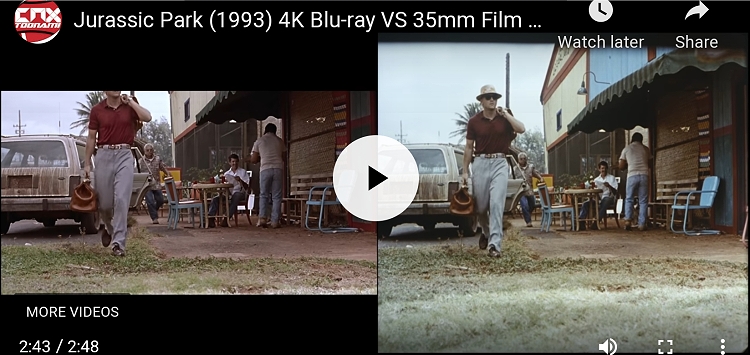Whereas before this, people went to the movies on a very regular basis for their entertainment. Now, they could get plenty of that entertainment in their living rooms. The image on TV sets was the same shape as the image on movie screens. Although TV programming at the time was only in black & white, a lot of movies were in black & white too, but color TV was on the way.
Secrets Sponsor
Hollywood decided to do something about this in a bid to attract consumers back into movie theaters. Widescreen movies were one of the answers. It means using a higher aspect ratio (AR), which is the ratio of the width of the image to the height of the image on the film (in inches or millimeters).
The concept of Widescreen was not new. A boxing match in Nevada in 1927 was filmed at 1.66:1, and on 63mm film. Movies from the silent era, in general, were shot at 1.33:1 on 35mm film. The AR does not include the sprocket holes on the side that are used to advance the film in cameras and projectors. In 1927, three side-by-side 1.33:1 cameras and projectors were used for the film Napoléon. This predates Cinerama’s use of three side-by-side cameras and projectors by more than twenty years. When I saw the Cinerama movie How the West Was Won in the early 1960s, I was stunned. The boundaries between the three images projected from three projectors were visible, but I did not care. In the Blu-ray release that I have, the production team assembled the three image elements together and eliminated the boundaries digitally, frame by frame. Because three cameras were used, the final combined image was the equivalent of using approximately a 9mm lens on a single piece of film, but without the “fisheye” look that such short focal length lenses tend to have. Cinerama® was a fabulous visual experience.
Here is a screenshot from the trailer of How the West Was Won. It was probably shown in a CinemaScope® format. You can see the boundaries between the three camera images. This is pretty much what it looked like in the Cinerama theater as I remember in 1962. The left and right edges have been cropped to fit in a 2.40:1 CinemaScope film strip. (All screenshots are copyrighted by the respective studios.)
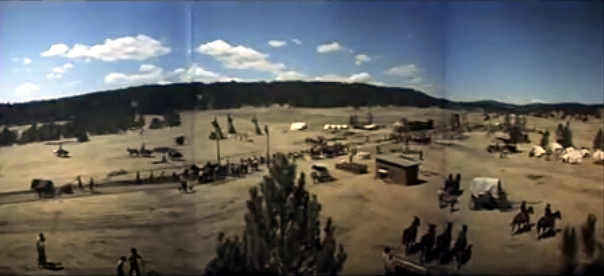
Here is the title screen with the boundaries between the three camera images digitally removed. This what it looks like in the Blu-ray version of the movie.
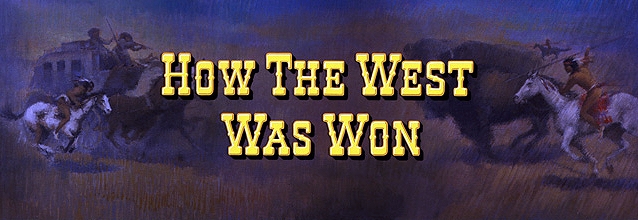
The Big Trail (1930) was shot simultaneously in several aspect ratios, including 2.10:1 on 70 mm film.
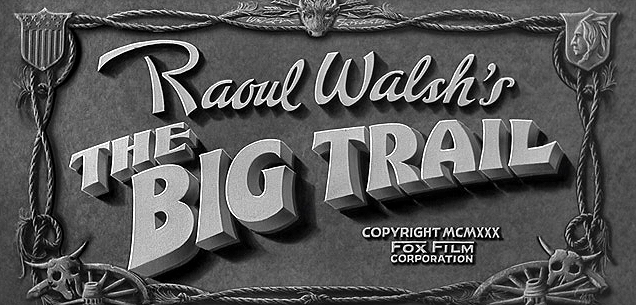
It was John Wayne’s first starring role, and the movie was a failure, unfortunately. But, as we know, this did not stop Wayne from having a very successful career.
Also from 1930, The Bat Whispers, shot in 65 mm.
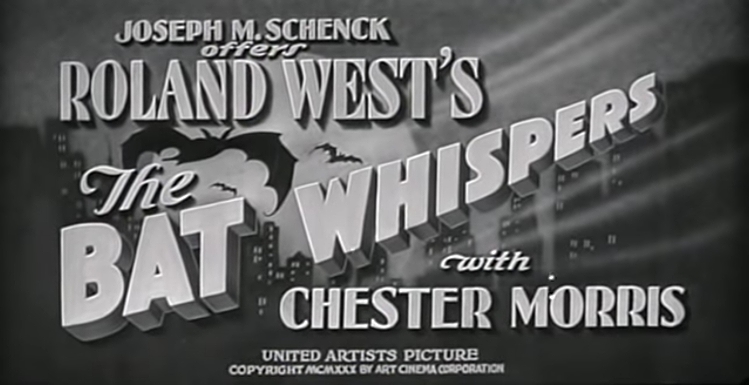
When sound came along in 1929, it was first supplied by a phonograph record that was played while the movie was being projected. Then, when an optical soundtrack was added along the side of the physical filmstrip, it reduced the aspect ratio of the image. Moviegoers didn’t like the almost square shape of the image, and theater projectors didn’t work very well with this anyway because they were set up for the original 1.33:1 film frame. In 1932, a standardized aspect ratio of 1.375:1 was formalized which reduced the height of the image and worked with the optical soundtrack on the side. From this point on, movies were shot with this Academy Ratio until the early 1950s. It was about a 15% reduction in the film frame of the silent era, which was not good since film in those days had a lot of grain. Shown below is a comparison of the 1.33:1 and 1.375:1 film frames.
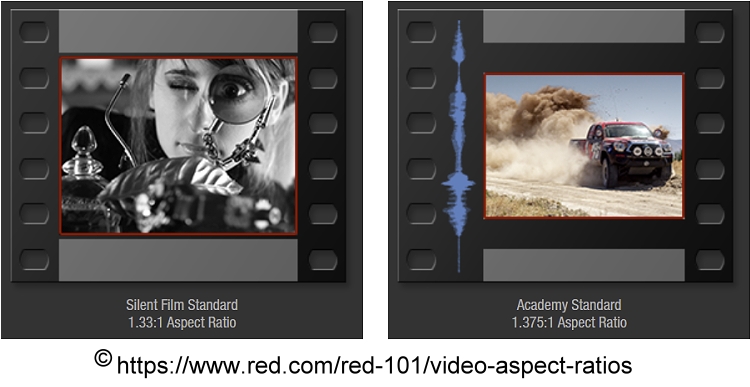
Widescreen disappeared for a while because it was just too expensive to shoot and too expensive for theaters to purchase additional projectors to handle the large film stock. The Wallstreet Crash of 1929 definitely contributed to this. They could have “matted” the standard film image (cropping the top and bottom) to create a higher aspect ratio in theaters, but film in those days was very grainy, so this alternative was not practical. Matting was used in the 1950s when finer grain film became available. An example is the 1953 movie Shane which was shot at an aspect ratio of 1.33:1 and matted to 1.66:1 for theaters. The 1.33:1 film was matted to a standard 1:85:1 final image in many movies, including some modern ones such as Back to the Future (1985) and Jurassic Park (1993).
Here is a comparison of a Jurassic Park scene in the matted version shown at theaters (on the left) and the non-matted full-frame (on the right). Frankly, I would prefer to view the movie in the non-matted version. It shows much more of the scene. Unfortunately, in many of the non-matted frames, microphones are visible at the top.
Shown below is a screenshot from The Phantom Creeps, a serial from 1939 with Bela Lugosi. It is in the 1.375:1 aspect ratio. These old serials from the 1940s are one of my current passions. They had from 12 to 15 chapters, each about 20 minutes long. Each chapter would end with one of the good guys in a serious predicament, like going over a cliff in a car or a buzz saw about to cut him/her in half. You can see that they were pretty “campy”, which basically means they were interesting because they were so ridiculous.

To compete with television, Hollywood re-invented the widescreen concept. Several new formats emerged from the various studios. Cinerama came about in 1952, with This Is Cinerama. It was more of a demonstration to see if the public would respond, rather than being an actual movie with a story. In 1953, 20th Century Fox studios announced CinemaScope®. It was a very clever idea because it “squeezed” a 2.40:1 image into the Academy film frame (it is actually 2.39:1, and just rounded to 2.40:1 for discussion). This was accomplished with a special “anamorphic” lens (a glass prism at first) in front of the conventional lens. So, if the conventional lens was 50mm in focal length, the anamorphic lens converted the horizontal focal length to 25mm. The vertical focal length continued to be 50mm. The resulting image on the film still had a 50mm field of view top-to-bottom (vertically) but was a 25mm wide-angle view side-to-side (horizontally). To be projected correctly, a reverse anamorphic lens had to be placed in front of the conventional projector lens at the theater. Theaters also had to mount a wider projection screen.
Shortly after CinemaScope films started to be released, a company called Panavision® began making lenses specifically for anamorphic photography with all lens elements built into one lens.
CinemaScope began with The Robe in 1953 and Demetrius and the Gladiators in 1954. These movies were shot at an AR of 2.55:1. Depending on the optical soundtrack, the final AR became 2.35:1 up to 2.40:1.

Here is what that same screenshot would have looked like on the 35mm film strip in the projector. It has been squeezed into the Academy film space. The anamorphic adapter on the front of the projector lens un-squeezed it for projection onto the movie screen in the theater.

At least the first few of these were shot simultaneously in 1.375:1 just in case audiences didn’t like the new widescreen format. But audiences went crazy over this, especially since the first CinemaScope movies were in color and with stereophonic sound. In some cases, there were four tracks, pre-dating our modern ‘surround sound”.
Here is a photo of a CinemaScope film strip showing where the four magnetic soundtracks were placed. The film sprocket holes would be between tracks 1 and 2, and between tracks 3 and 4. The sound channels were left, center, right, and rear surround (“Effects”).
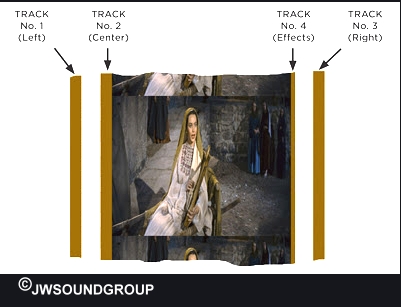
The same visual effect could be achieved by simply shooting the movie with a conventional 25mm lens (for the wide-angle shots) and then matting the image in the projector by cropping the top 25% and bottom 25%, but the image would have been grainy and not very bright. Besides, 20th Century wanted a process they could copyright and license to other studios.
Meanwhile, those other studios had other ideas. Paramount created VistaVision® which was 35mm moving horizontally in the camera rather than vertically, and the film space was 24mm x 36mm, which was more than twice the area of a standard 1.375:1 Academy film frame on vertically running 35mm film. It was a non-anamorphic process. They were usually printed onto the Academy film space for viewing because theaters did not want to invest in projectors that ran side-to-side just to show them.
Many movies were made with this format, and perhaps the most famous is The Ten Commandments, released in 1956. It had Cecil B. DeMille as director and a lot of big stars, including Charlton Heston, Yul Brynner, and Edward G. Robinson.
VistaVision® movies were made such that theaters could choose between several AR projection modes to suit their own tastes. Full frame, it was 1.5:1 but was expected to be shown at other aspect ratios, such as 1.85:1. The Ten Commandments was indeed released at higher aspect ratios, and on 70mm film, in later years. But, I remember seeing it in 1956 when our school class was taken on the school bus to the theater. It was in 1.85:1 I think. It is one of the few movies that I distinctly remember as a child (I was 11 in 1956).
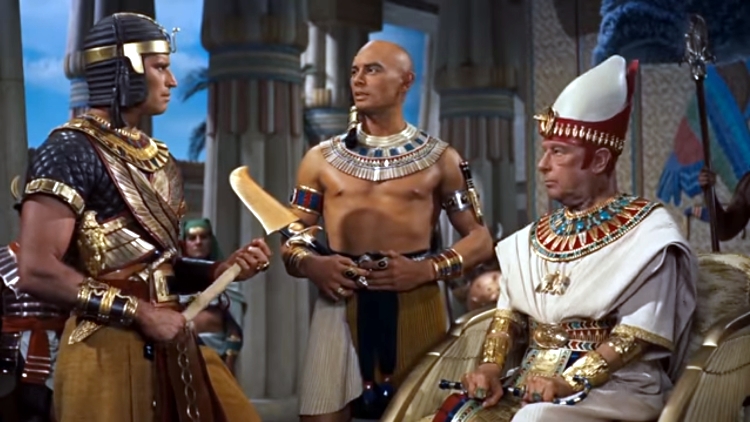
Here is what it would look like matted to 2.10:1:
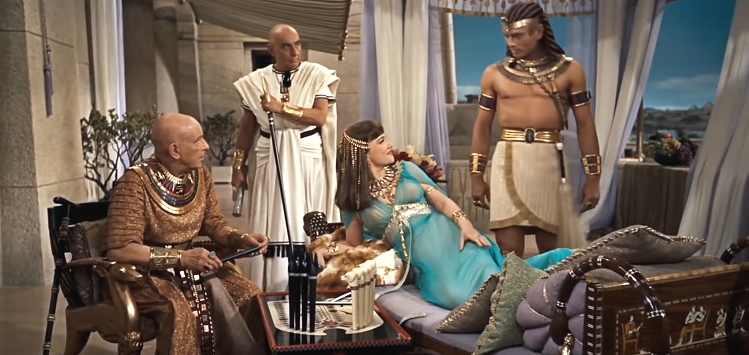
Old VistaVision® cameras were used for some of the special effects in the Star Wars movies.
One other old movie that I distinctly remember was The Conqueror (1956) which was a CinemScope film. It starred John Wayne as Temujin, also known as Genghis Khan, and was considered his worst movie ever, but I enjoyed it.
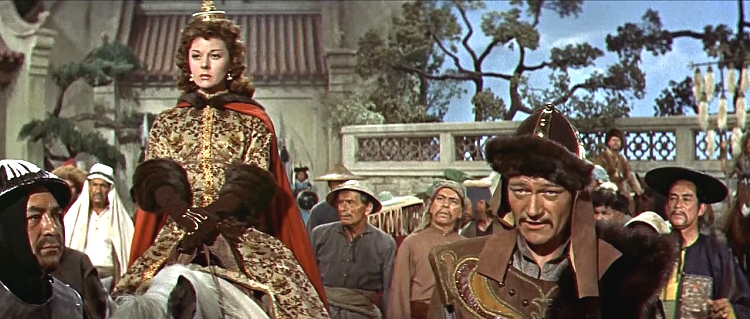
Other formats included Technirama® (1957) and Techniscope® (1960). Spartacus (1960), a screenshot shown below, was a Technirama film with an AR of 2.20:1. Technirama was similar to VistaVision except that anamorphic lenses were used. Release prints were often on 70mm film.
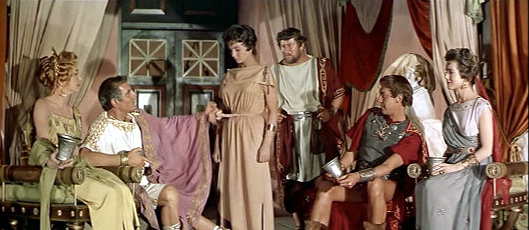
As time marched on, more and more films were shot in widescreen format, and less in the standard Academy ratio of 1.375:1. Films shot on large format film also became popular again, such as Ben-Hur (1959), which was on 65mm film, but anamorphic, to produce a final AR of 2.76:1. It looked great for scenes like this:
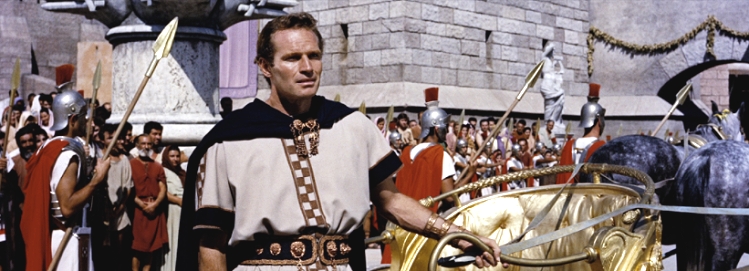
And especially like this:
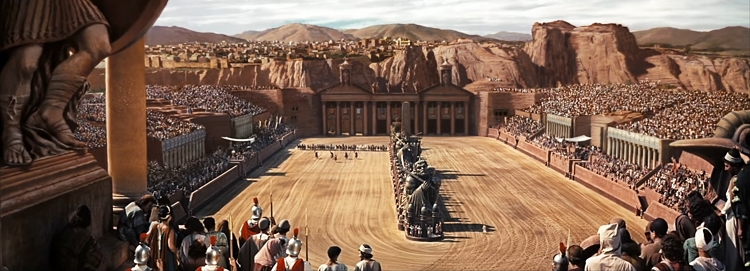
But close-ups like this were a bit too wide. They did not look natural.
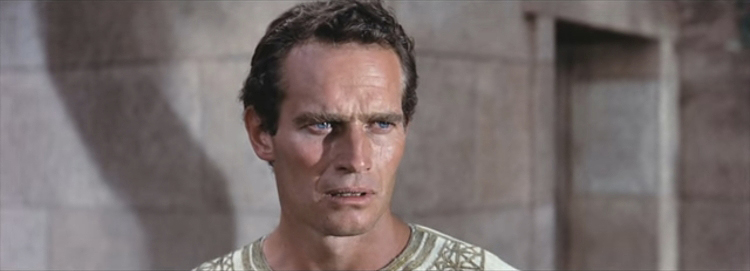
Ben-Hur: A Tale of the Christ was also a silent movie in 1925. It was shot at the 1.33:1 AR of the silent era. Both versions were based on the same book by Lew Wallace, published in 1880. Here is a screenshot from that 1925 movie:
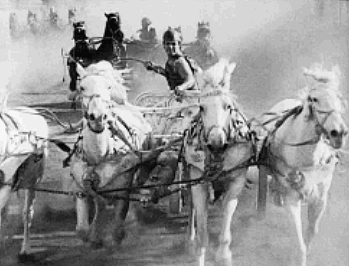
Here is a cropped section of that same type of scene in the 1959 movie, what it would have looked like if it were shot the same way as in 1925.
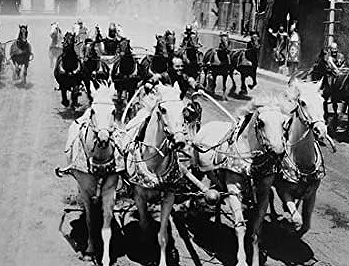
Now, the same view (approximately) as it appeared in the 1959 movie.
![]()
Lawrence of Arabia (1962) was also on 65mm film but not anamorphic (shot with Super Panavision 70® lenses), and released on 70mm prints, so the AR was 2.20:1.
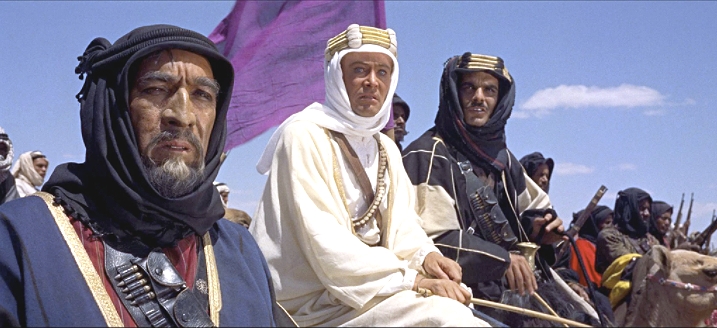
Todd-AO® was another 70mm format, introduced by Michael Todd in 1955 with the release of the movie Oklahoma. It used huge lenses and was 30 frames per second (fps) instead of the typical 24. This eliminated flicker. The movies were shot on 65mm film and then printed onto 70mm film at 2.20:1 AR for projection. The extra space was used for the six soundtracks. It required a special curved screen that gave 1280 of viewing angle. Here is a shot from Cleopatra (1963), which starred Elizabeth Taylor (she married Michael Todd in 1957, and he was killed in a plane crash in 1958).
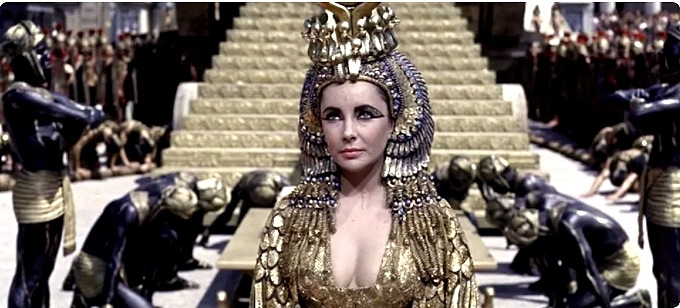
Movies in the past couple of decades have tended to be either 1.85:1 or 2.40:1 and on 35mm film, with the 2.40:1 movies being shot using anamorphic lenses. However, a few years ago, studios informed theaters that unless they converted their projectors to digital, they would not be getting any new movies to show their audiences. So, theaters bit the bullet and put in digital projectors.
Movies are still 1.85:1 or 2.40:1 but are shot with digital movie cameras rather than film cameras. The 1.85:1 movies are shot close to full-frame as that is the AR of the digital camera sensor. But 2.40:1 movies are simply letterboxed on the sensor and the projector. A few are shot with anamorphic lenses and then changed to 2.40:1 non-anamorphic letterboxed for theater projectors.
A table listing all the film formats is shown below.
Like analog LP (vinyl) and film cameras which are making a comeback, interest in producing movies in the old 1.375:1 AR are also in the plans of movie companies. Perhaps just to be different. I hope they also release some in black & white, like the Film Noir of the 1940s and 1950s. How about another Dial M for Murder (Alfred Hitchcock, 1954) type of movie instead of Godzilla vs. Kong? How about another Film Noir This Gun for Hire (1942) (screenshot below). It had Alan Ladd and Veronica Lake. Light and shadow were hallmarks of the Film Noir.
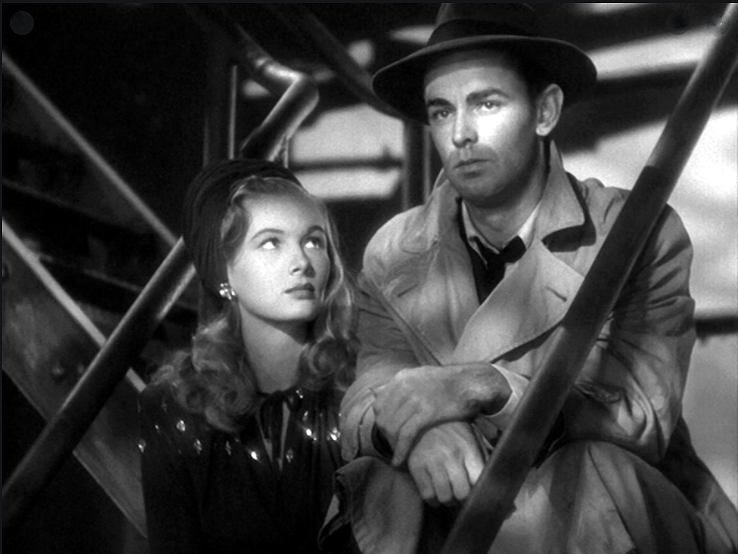
Come on, let’s go back to acting, story, script, and great (real, not CGI) photography, rather than just a sensory experience.
When widescreen movies were shown on TV in the 1950s up to a few years ago, they were shown in “Pan & Scan” format, which meant that only a portion of the movie image could be seen, since TVs had an AR of 1.33:1. Sort of like that 1.33:1 cropped image from the 1959 Ben-Hur movie shown several images back in this article. When 16:9 HDTVs became available, they started to be shown in their full aspect ratio, and this was called “Letterboxing”. They actually started doing this on conventional TVs shortly before HDTVs became available. There were (and still are) black horizontal bars at the top and bottom of the screen so that the full widescreen image fits.
This is what letterboxed Ben-Hur (1959) would look like on an HDTV. Note also that our current HDTVs would be considered as ‘Widescreen” too since they have a wider aspect ratio (16:9 = 1.77:1) compared to the old TVs (1.33:1) and old movies (1.375:1).
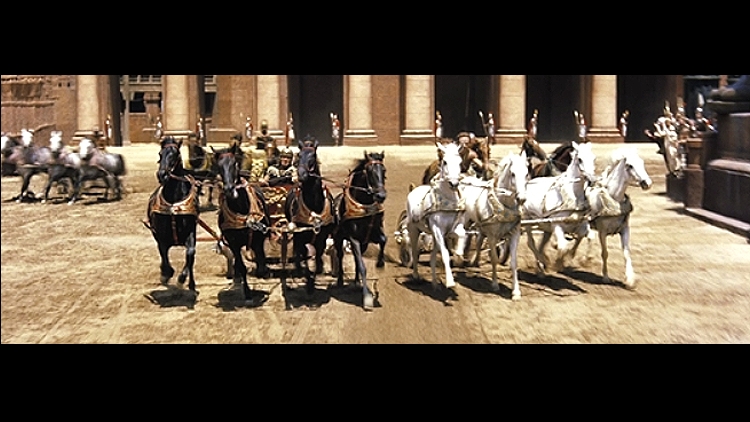
Now, a complaint. In the past few years, when I went to our local AMC Theater, where they had updated their projection system to digital, the image was so bright, I had to wear dark glasses. In fact, the image was simply letterboxed within the digital projector chip, and the black bars at the top and bottom were visible on the projection screen. The increased brightness completely destroyed the black levels. Here is what a typical scene would look like. Notice the bars at the top and bottom. They are not black. So, essentially, color quality was reduced because the saturation was messed up due to so much brightness.

Also, the image was the same width as other movies that had a lower AR, such as 1.85:1, and in this case, the entire digital projection chip was used. So, for example, the above screen would be filled with a movie scene. There would not be any black bars at the top and bottom.
Therefore, the term “Widescreen” no longer existed, because all movies were being shown at the same width, compared to the old days, when widescreen movies were projected onto a screen that was actually wider (in feet) than the screen onto which 1.85:1 movies were projected. All movies were projected at the same height rather than the same width.
Lastly, the surround sound was so loud, I had to put pieces of my napkin (from my popcorn) into my ears. Other people to whom I have spoken about this problem noticed the same thing. I suspect this problem is caused by having so many channels such as with Dolby Atmos. If 15 channels are going, each with a powerful amplifier, there is going to be a lot of air moving.
To me, this is a disaster. I no longer go to movie theaters (even before COVID-19) and do not intend to go to them now or later unless they remedy this. I don’t know if this situation exists in all, most, or just a few commercial theaters, but it exists in the theater I was going to.
Because I can watch letterboxed widescreen movies on my 4K UHDTV at home, with the proper black levels, color saturation, and surround sound that does not make me cringe from the sound volume, that is where I watch current movies after they come out on disc or streaming services. Why pay $15 at a theater to watch a 2.40:1 letterboxed movie on the same size screen that they would show a 1.85:1 movie and with crushed black levels and ear-shattering sound volume? Exactly. No thanks.
So, a message to Hollywood and commercial theaters: Put a zoom lens on the projector and increase the width of the projected movie image from 2.40:1 AR films compared to 1.85:1 films. I assume you still have the original wide movie screens from the old days. Keep the projected image at the same height for all movies. Turn down the brightness so that blacks are actually black. Turn down the surround sound volume. Otherwise, trouble is coming. Just like it did in the early 1950s.
As an aside, you can create your own panoramic photographs with your digital camera. This will only work with a static scene, such as shown below. Take two or three photos from left to right or right to left, with the side edges of each of the photos overlapping just a bit. Make sure to maintain the height of the camera the same as you move it for each photo. Then, if you have Photoshop, open a new project (File, New). Then go to File, Automate, Photomerge. Open the two or three photos in your panorama set by clicking on Browse and selecting the photos. Select Auto, Cylindrical, or Spherical and then OK. Your panorama will be created. You may have to crop it on the top and bottom to make the photo completely rectangular. Save it as a TIF, and then save it as a JPG for printing at Costco or wherever you want to print it. I have used Bayphoto with good results.
The panorama shown below was created with two photos. It has a final AR of 2.77:1, similar to the AR in Ben-Hur (1959). I took this panorama in a fjord in Norway.

You can also create panoramic photos with your smartphone camera, but there is quite a bit of spherical distortion. Perhaps some photo software app could flatten this out.
Secrets Sponsor
Because 2.40:1 movies are now shown letterboxed at theaters and in our homes, the resolution of the movie is half of what the full screen is. So, even with a UHD-TV (4K), the movie is only in (approximately) 2K because the top (approximately) 25% and bottom 25% of the 4K screen are blank. I would like to see 2.40:1 movies shot with anamorphic lenses so that the entire digital sensor in the camera is used for the image that will eventually be the movie. It would be squeezed side-to-side like old CinemaScope movies, except that the amount of squeeze would not be as much because the digital sensor is wider (the AR) than the Academy film space. Then, at movie theaters, the entire digital projector chip would have a movie image that would be un-squeezed by an anamorphic lens on the front of the projector, just like they were with CinemaScope movies in theaters way back in the day. The resulting movie image on the projection screen would be in 4K rather than 2K. It would be seen on a wider screen than 1.85:1 movies, just like they were back then. For home use, we could choose between a version that is letterboxed for use on a UHD-TV or anamorphic for use with a UHD-TV projector. That way, we would truly have 4K resolution in our widescreen movies. Old movies that were shot on a large film space, e.g., 70mm, could be digitally squeezed so they could be projected using almost the full digital projection chip and the anamorphic projection lens. Since movie studio digital video cameras don’t all have the same aspect ratio, and neither do movie theater digital projectors, some sort of standardization would have to occur – perhaps easier said than done.



